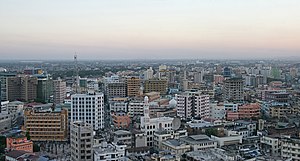Portal:Tanzania
 The Tanzania Portal
Tanzania, officially the United Republic of Tanzania, is a country in East Africa within the African Great Lakes region. It is bordered by Uganda to the northwest; Kenya to the northeast; the Indian Ocean to the east; Mozambique and Malawi to the south; Zambia to the southwest; and Rwanda, Burundi, and the Democratic Republic of the Congo to the west. Mount Kilimanjaro, Africa's highest mountain, is in northeastern Tanzania. According to the 2022 national census, Tanzania has a population of nearly 62 million, making it the most populous country located entirely south of the equator. Many important hominid fossils have been found in Tanzania, such as 6-million-year-old Pliocene hominid fossils. In the Stone and Bronze Age, prehistoric migrations into Tanzania included Southern Cushitic speakers who moved south from present-day Ethiopia; Eastern Cushitic people who moved into Tanzania from north of Lake Turkana about 2,000 and 4,000 years ago; and the Southern Nilotes, including the Datoog, who originated from the present-day South Sudan–Ethiopia border region between 2,900 and 2,400 years ago. These movements took place at about the same time as the settlement of the Mashariki Bantu from West Africa in the Lake Victoria and Lake Tanganyika areas. In the late 19th century, the mainland came under German rule as German East Africa, and this was followed by British rule after World War I when it was governed as Tanganyika, with the Zanzibar Archipelago remaining a separate colonial jurisdiction. Following their respective independence in 1961 and 1963, the two entities merged in 1964 to form the United Republic of Tanzania. Tanganyika joined the British Commonwealth and Tanzania remains a member of the Commonwealth as a unified republic. Tanzania is mountainous and densely forested in the north-east, where Mount Kilimanjaro, the highest mountain in Africa and the highest single free-standing mountain above sea level in the world, is located. Three of Africa's Great Lakes are partly within Tanzania. To the north and west lie Lake Victoria, Africa's largest lake, and Lake Tanganyika, the continent's deepest lake, known for its unique species of fish. To the south lies Lake Malawi. The eastern shore is hot and humid, with the Zanzibar Archipelago just offshore. The Menai Bay Conservation Area is Zanzibar's largest marine protected area. The Kalambo Falls, located on the Kalambo River at the Zambian border, is the second-highest uninterrupted waterfall in Africa. Tanzania is one of the most visited tourist destinations for safaris. Selected article -The Maasai (/ˈmɑːsaɪ, mɑːˈsaɪ/; Swahili: Wamasai) are a Nilotic ethnic group inhabiting northern, central and southern Kenya and northern Tanzania, near the African Great Lakes region. The Maasai speak the Maa language (ɔl Maa), a member of the Nilotic language family that is related to the Dinka, Kalenjin and Nuer languages. Except for some elders living in rural areas, most Maasai people speak the official languages of Kenya and Tanzania, Swahili and English. The Maasai population has been reported as numbering 1,189,522 in Kenya in the 2019 census, compared to 377,089 in the 1989 census, though many Maasai view the census as government meddling and therefore either refuse to participate or actively provide false information. (Full article...)General images -The following are images from various Tanzania-related articles on Wikipedia.
This month in Tanzanian history
Wildlife of Tanzania - Credit: M. Disdero
The African Bush Elephant (Loxodonta africana) is the larger of the two species of African elephant. Both it and the African Forest Elephant have usually been classified as a single species, known simply as the African Elephant. Some authorities still consider the currently available evidence insufficient for splitting the African Elephant into two species. It is also known as the Bush Elephant or Savanna Elephant. Did you know ...
CategoriesWikiProjectsRecognised contentSelected panorama -The Uluguru Mountains, a mountain range in eastern Tanzania. The mountains are named after the Luguru people.
Uganda–Tanzania War -Articles here focus upon aspects of the Uganda–Tanzania War. These are all Good articles that meet a core set of high editorial standards.
The Battle of Entebbe was a battle of the Uganda–Tanzania War that took place on 7 April 1979 on the Entebbe peninsula in Uganda between Tanzanian units and Ugandan and Libyan units. The Tanzanians occupied the area, killed hundreds of Libyans, and ended the Libyan airlift in support of the Ugandan government. Idi Amin had seized power in Uganda in 1971 and established a brutal dictatorship. Seven years later he attempted to invade neighbouring Tanzania to the south. The attack was repulsed, and Tanzanian President Julius Nyerere ordered a counter-attack into Ugandan territory. As Tanzanian forces advanced deeper into the country, Libya sent its own troops to support the Ugandans, flying them in to the airport at Entebbe. From their position in Mpigi the Tanzanians could see the Libyan air traffic, so they decided to attack the location to stop the airlift and eliminate a potential flank attack ahead of their assault on Kampala. (Full article...)TopicsSelected picture - Credit: Muhammad Mahdi Karim
Dar es Salaam is the largest city in Tanzania. It is also the country's richest city and a regionally important economic centre. ...Archive — Nominations
Related portalsThings you can doAssociated WikimediaThe following Wikimedia Foundation sister projects provide more on this subject:
Discover Wikipedia using portals | ||||








































































